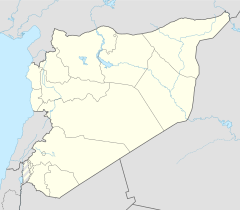Qasr al-Hayr al-Gharbi
| Qasr al-Hayr al-Gharbi قصر الحير الغربي | |
|---|---|
 Qasr al-Heer al-Gharbi facade | |
| General information | |
| Town or city | Homs Governorate |
| Country | Syria |
| Coordinates | 34°22′28″N 37°36′21″E / 34.374444°N 37.605833°E |
Qasr al-Hayr al-Gharbi (Arabic: قصر الحير الغربي) is a castle or qasr located 80 km south-west of Palmyra on the Damascus road in Syria, is a twin palace of Qasr al-Hayr al-Sharqi, built by the Umayyad caliph Hisham ibn Abd al-Malik in 727 CE. It was built in the Byzantine architectural style.
Description
Qasr al-Hayr al-Gharbi is one of a number of desert castles in the Syrian/ Jordanian region. The site originally consisted of a palace, a bath, an irrigated garden and another building which scholars suggest may have been a caravanserai. Over the entrance is an inscription which declares that the it was built by Hisham in the year 727, a claim that is borne out by the architectural style. [1]
It was used as an eye of the king during the Umayyad era, to control the movement of the desert tribes and to be a barrier against them, as well as being a hunting lodge. Later it was utilized by the Ayyubids and the Mamelukes but was abandoned permanently after the Mongol invasions.
The castle is quadrangular in outline with 70-meter sides. The central doorway to the castle is very attractive, and has been moved to the National Museum of Damascus to be used as the entrance. Its semi-cylindrical towers on the sides of the doorway, columns, and the geometric shapes mirrored a blend of Persian, Byzantine and Arab architecture.
Not much remained from the castle. Only visible is a reservoir to collect water from Harbaka dam, a bath and a khan.
The gateway is preserved as a façade in the National Museum of Damascus.
References
This article includes a list of references, related reading, or external links, but its sources remain unclear because it lacks inline citations. (February 2017) |
- ^ Fowden, G., Qusayr 'Amra: Art and the Umayyad Elite in Late Antique Syria, University of California Press, 2004 p. 157


